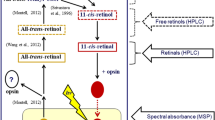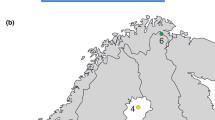Summary
The amphipod, Orchomene plebs, and the isopod, Glyptonotus antarcticus, both adapted to live in seawater of a temperature of-2° to 0° C, were kept for 7h at the unphysiologically high temperature of +10° C. Temperature elevation appeared to mimic light adaptation with regard to the position of the screening pigment granules within the visual cells, but not with respect to ultrastructural changes in the microvillar array of the rhabdom, i.e. the visual membranes. Cellular metabolism, membranous fatty acid composition, and ion fluxes, all known to be readily affected by an increase in temperature, are thought to be responsible for the observed effects. Pigment granules could possibly cause an elevation of intracellular temperatures due to the fact that they are dark and dissipate absorbed energy as heat.
Similar content being viewed by others
References
Ali MA (1960) The effect of temperature on the juvenile sockeye salmon retina. Can J Zool 38:169–171
Ali MA (1975) Temperature and vision. Rev Can Biol 34:131–186
Ali MA, Steele VJ (1961) Retinomotor responses of the amphipod Gammarus oceanicus from two latitudes to various light intensities and temperatures. Rev Can Biol 20:665–674
Anderson RE (1978) Essential fatty acid deficiency and photoreceptor membrane renewal — a reappraisal. Invest Ophthalmol Vis Sci 17:1102–1104
Arey LB (1916) The influence of light and temperature upon the migration of the retinal pigment of Planorbis trivolis. J Comp Neurol 26:359–389
Behrens ME (1974) Photomechanical changes in the ommatidia of the Limulus lateral eye during light and dark adaptation. J Comp Physiol 89:45–57
Bennitt R (1924) The migration of the retinal pigment in crustaceans. J Exp Zool 40:381–435
Bennitt R (1932) Diurnal rhythm in the proximal pigment cells of crayfish retina. Physiol Zool 5:49–65
Besharse JC, Hollyfield JG, Rayborn ME (1977) Photoreceptor outer segments: accelerated membrane renewal in rods after exposure to light. Science 196:536–538
Chamberlain SC, Barlow RB (1979) Light and efferent activity control rhabdom turnover in Limulus photoreceptors. Science 206:361–363
Congdon ED (1907) The effect of temperature on the migration of retinal pigment in decapod crustaceans. J Exp Zool 4:539–548
Daemen FJM (1973) Vertebrate rod outer segment membranes. Biochim Biophys Acta 300:225–264
Day M (1941) Pigment migration in the eyes of the moth Ephestia kuehniella. Biol Bull 80:275–291
Frixione E, Arechiga H, Tsutsumi V (1979) Photomechanical migrations of pigment granules along the retinula cells in the crayfish. J Neurobiol 10:573–590
Henkes HE (1952) Retinomotor and diurnal rhythm in crustaceans. J Exp Biol 29:178–191
Herzog H (1905) Experimentelle Untersuchung zur Physiologie der Bewegungsvorgänge in der Netzhaut. Arch Anat Physiol 5:413–464
Hinckley RE, Samson FE (1974) The effects of an elevated temperature, colchicine and vinblastine on axonal microtubules of the crayfish Procambarus clarkii. J Exp Zool 188:321–336
Hollyfield JG (1979) Membrane addition to photoreceptor outer segments: progressive reduction in the stimulatory effect of light with increased temperature. Invest Ophthalmol Vis Sci 18:977–981
Hollyfield JG, Besharse JC, Rayborn ME (1977) Turnover of rod photoreceptor outer segments: membrane addition and loss in relationship to temperature. J Cell Biol 75:490–506
Itaya SK. (1976) Rhabdom changes in the shrimp Palaemonetes. Cell Tissue Res 166:265–273
Littlepage JL (1965) Oceanographic investigations in the McMurdo sound. Biol Antarctic Seas Vol 2 (Antarctic Res Ser 5): pp1–37
Meyer-Rochow VB (1974) Structure and function of the larval eye of the sawfly Perga sp. (Pergidae, Hymenoptera). J Insect Physiol 20:1565–1591
Meyer-Rochow VB, Pyle CA (1980) Fatty acid analysis of lens and retina of two Antarctic fish and of the head and body of the Antarctic amphipod Orchomene plebs. Comp Biochem Physiol 65 B:395–398
Meyer-Rochow VB, Tiang KM (1979) The effects of light and temperature on the structural organization of the eye of the Antarctic amphipod Orchomene plebs (Crustacea). Proc R Soc Lond 206:353–368
Meyer-Rochow VB, Waldvogel H (1979) Visual behaviour and the structure of dark and light-adapted larval and adult eyes of the New Zealand glowworm Arachnocampa luminosa (Mycetophilidae, Diptera). J Insect Physiol 25:601–613
Miller WH, Cawthon DF (1974) Pigment granule movement in Limulus photoreceptors. Invest Ophthalmol Vis Sci 13:401–405
Murphy DB, Tilney LG (1974) The role of microtubules in the movement of pigment granules in teleost melanophores. J Cell Biol 61:757–779
Novales RR, Novales BJ, Zinner SH, Stoner JA (1962) The effects of sodium, chloride and calcium concentration on the response of melanophores to MSH. Gen Comp Endocrinol 2:286–295
Opalinski KW (1974) Standard, routine, and active metabolism of the Antarctic amphipod Paramoera walkeri Stebbing. Pol Arch Hydrobiol 21:423–429
Tasaki I, Iwasa K (1980) Swelling of nerve fibers during action potentials. Ups J Med Sci 85:211–215
Thorson G (1964) Light as an ecological factor in the dispersal and settlement of larvae of marine bottom invertebrates. Ophelia 1:167–208
Tsin ATC, Beatty DD (1977) Visual pigment changes in rainbow trout in response to temperature. Science 195:1358–1360
Veron JEN (1976) Responses of Odonata chromatophores to environmental stimuli. J Insect Physiol 22:19–30
Walcott B (1975) Anatomical changes during light adaptation in insect compound eyes. In: Horridge GA (ed) The compound eye and vision in insects. University Press, Oxford, 20–33
White RN, Lord E (1975) Diminution and enlargement of the mosquito rhabdom in light and darkness. J Gen Physiol 65:583–598
Young RW (1967) The renewal of photoreceptor outer segments. J Cell Biol 33:61–72
Author information
Authors and Affiliations
Rights and permissions
About this article
Cite this article
Meyer-Rochow, V.B., Tiang, K.M. Comparison between temperature-induced changes and effects caused by dark/light adaptation in the eyes of two species of Antarctic crustaceans. Cell Tissue Res. 221, 625–632 (1982). https://doi.org/10.1007/BF00215706
Accepted:
Issue Date:
DOI: https://doi.org/10.1007/BF00215706




